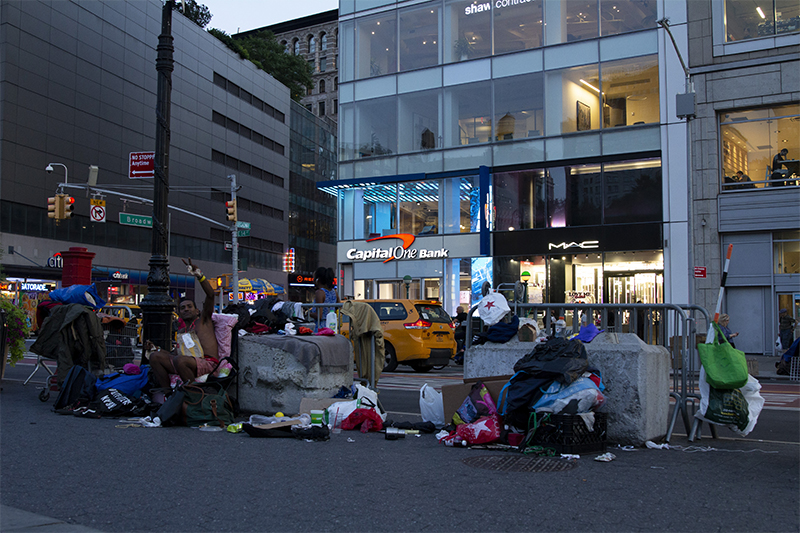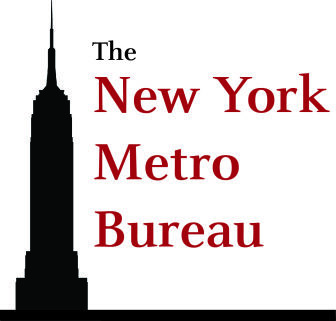
Niamh McDonnell
This file photo of Manhattan is from 2019.
UPDATE: A young man staying in a Sheltering Arms youth shelter tested positive for COVID-19 Monday. The Chronicle of Social Change reported that he had been isolated. The Coalition for Homeless Youth and Legal Aid Society called for increased financial support from the city for homeless youth providers. Read the full statement here.
NEW YORK — As a global pandemic looms over New York City, one group in particular might be getting left behind, homeless youth — a vulnerable subset of the general homeless population made up of runaway youth, LGBTQ teens and other young people experiencing homelessness.
As confirmed cases ramp up to more than 9,000, New York City homeless shelters are put in a particularly precarious situation. New Yorkers are encouraged to keep six feet away from each other and self-isolate when necessary — a nearly impossible challenge for people who must live in group settings like shelters.
 While the Department of Homeless Services has released guidelines for how adult homeless shelters should respond to health guidelines, the agency that oversees youth shelters, the Department of Youth and Community Development (DYCD), has not released its own set of guidelines.
While the Department of Homeless Services has released guidelines for how adult homeless shelters should respond to health guidelines, the agency that oversees youth shelters, the Department of Youth and Community Development (DYCD), has not released its own set of guidelines.
It doesn’t make sense to create blanket guidelines, as each youth shelter is so different, said Randy Scott, the agency’s runaway and homeless youth service coordinator.
Providers are in the process of planning how youth shelters — which are smaller shelters that usually include no more than 20 beds — are going to handle the global pandemic as it runs rampant in New York City. Some advocates see the agency’s reluctance to put out guidelines as dangerously negligent.
DYCD’s “complete negligence of the needs of youth experiencing homelessness and their contracted providers regarding the COVID-19 pandemic is dangerous and exemplary of the mismanagement in their agency,” the Coalition for Homeless Youth said in a statement.
Butting heads
In the last week, a few nonprofits have taken to opinion columns to express their frustrations with how the city is handling social, particularly youth shelters. Michelle Yanche, the executive director of Good Shepherd Services, which offers residential housing for at-risk New York City youth, wrote that the city is not providing guidance fast enough to social service workers. The city’s hands-off approach is leaving providers uncertain about whether they can close certain programming for the safety of their staff and not incur huge financial cuts, she said.
“While many companies and individuals have the ability to pack up their laptops and head home to weather the storm, it’s a different reality for those in the social services sector,” Yanche wrote. “Our staff are the ones on the front lines every day, risking their own health to ensure New Yorkers have what they need when it matters the most.”

Jeremy Kohomban
President of The Children’s Village Jeremy Kohomban, wrote in amNY about his concerns for the Dobbs Ferry, N.Y., temporary home for roughly 300 children in New York City, with 112 staff members on site.
“We are following government guidelines to ensure that we are taking every necessary precaution, including performing daily sanitation of all our facilities, no small task given our size,” Kohomban wrote. “But we need to do much more than that.”

Beth Hofmeister
While it’s true that all youth shelters operate differently based on their size and various services, DYCD has the power to control larger decisions such as shutting down certain programming, staggering staff schedules and designating shelters as isolation centers, said Beth Hofmeister, a Legal Aid Society homeless rights attorney.
“Right now, it kind of feels like you have to give all the services or nothing,” Hofmeister said. “But [the DYCD] has an ability to look at the system as a whole to figure this out.”
Scott said that daily communication and following the safety guidelines already set by the New York City Department of Health and the state has so far been successful.
“Everybody is moving at an expeditious rate,” Scott said. “Communication has been at an all-time high. Collaboration has been at an all-time high.”
But Kohomban said that while he has received several long emails from the city agency, they have yet to offer any concrete help. And the city isn’t seeking out input from The Children’s Village in its planning process, he said.
‘We are on the front lines doing this work every day,” Kohomban said in an email. “Why not include us in the planning? We have good ideas that should make this more manageable. We are all in this together. Government should not feel that they MUST have all the answers — we have very good and pragmatic ideas as well.”
There are some providers who think DYCD is doing a good job communicating with agencies.

Keisha Phipps
Keisha Phipps, the vice president and chief administrative officer of CORE Services Group, said the DYCD is publishing daily vacancies so that all providers know what’s available and can connect young people with open beds at any DYCD-funded shelter.
“We’re very collaborative in that space,” she said. “All the providers really work together to make sure that there’s never a young person who doesn’t have a bed. The alternative right now is couch surfing or living on the street, and that’s not even an option right now.”
Everyone is generally very communicative in the Department of Homeless Services and DYCD, but now they’re all ramping up communication and acting as quickly as possible, Phipps said.
What’s open
Since homeless shelters are considered “essential business entities,” all DYCD-funded runaway and homeless youth programs remain open to some degree. For many shelters, this means keeping essential support programs — such as overnight facilities and meal services — open while suspending other in-person services like mental health counseling or community-based workshops.
However, several providers seem to have stopped their nonresidential services. For instance, The Door, a South Bronx-based organization that provides services to runaway and homeless youth but not shelter, has closed their doors until at least March 30. They’re offering food and hygiene kits that can be picked up at their center.
Calls to several organizations, including Girls Educational & Mentoring Services, Good Shepherd Services and Diaspora Community Services, suggest that their nonresidential services have paused and administrative staff is working from home.
As Phipps said, many runaway and homeless youth have faced overlapping challenges including trauma, abuse and neglect in their homes. So continuing as many support services as possible may be essential for some homeless youth, especially during this time.
Staffing issues
Staffing has proven to be the most pressing issue for providers, given that many shelters rely on support from interns from graduate social work programs. The closure of city colleges and universities has sent many of these students home.

Jamie Powlovich
“You’re dealing simultaneously with a staff capacity issue because of the virus itself, because of child care issues, parents having to stay home with their kids, and now, losing intern staff capacity because of the closing of the colleges,” said Jamie Powlovich, executive director of the Coalition for Homeless Youth.
Shelters are tinkering with solutions to this. Kohomban explained how Children’s Village has been managing: “We’re implementing staggered schedules to accommodate social distancing, providing all the cleaning supplies and services we can, and any staff who are sick in any way must stay home. It’s certainly an adjustment, but we’re not experiencing any major issues so far.”
Scott said he is dealing with staffing shortages on a case-by-case basis.
“We’re allowing providers to tell us what their capacity is to operate,” he said. “… We’ll look at the possibility of reducing certain services like workshopping that maybe don’t have to happen at this current time.”
Phipps said CORE has created an “emergency schedule,” which includes a shift reduction, information about which employees live closest to the facilities and a plan for what will happen in the case of employees calling out of work. They’re currently looking into cross-training some employees so that they’re prepared to perform operational duties outside their normal roles. But, Phipps said, she’s impressed by how many employees haven’t called out of work.
“We’re saying to our staff, ‘We need you to come to work,’ and they’ve come to work,” she said. “They’ve come early and they stayed late. They understand that this is their responsibility.”
While these are solutions that work right now, in several weeks, when scientists predict the pandemic will begin to peak across the United States, Kohomban says he does not feel prepared: “We don’t have what we need yet.”
Specifically, he said his shelter doesn’t have the personal protective equipment and supplies necessary to quarantine residents on site.
Quarantining
Scott said on Thursday that there were no confirmed cases of COVID-19 in the youth shelters yet, but some teens have shown symptoms and were either isolated or taken to the hospital.
“For every case that has been called in, they’ve gotten great advice from the Department of Health and they’ve been able to address the matter,” Scott said. “Now, I think they’re managing very well and the feedback has been good.”
What to do with teens who are beginning to show symptoms is still unclear for many providers. For some smaller shelters, it can be difficult to isolate them. Powlovich likens the shelter size to a typical New York City-sized apartment — some shared living spaces have only one bathroom.
“Someone that’s supposed to be quarantined … they still are coming out to a common area that everyone shares, using a bathroom that everyone shares,” she said. “Raising a lot of the same concerns about what this looks like for anyone living in smaller living quarters.”
Powlovich said it is up to the DYCD to figure out how to provide a safe space to isolate people who are showing symptoms, as well as provide staffing for these isolation centers.
Scott said DYCD has been working with the mayor’s office this week to look into other types of isolation locations. In the meantime, he says sheltering in place is working and that most shelters do have an additional bathroom to spare for quarantining residents.
CORE shelters haven’t had any positive cases yet, Phipps said, but were able to successfully quarantine a young client who had been showing flu-like symptoms about a week ago. After the client was returned from the hospital with a flu diagnosis, the CORE facility quarantined the client in her own room and gave her a separate bathroom as well as a small refrigerator.
It’s unclear how shelters are vetting people who come in and out. Powlovich said she believes shelters are screening people for symptoms as they come in and flagging them to be quarantined or hospitalized. But as many people can be infected with the virus for up to 14 days without showing symptoms, it can be hard to track or monitor whether COVID-19 is entering these shelters.
Symptom of larger problem
As youth shelters and DYCD continue to adjust as this pandemic unfolds, Hofmeister urges the city to think about the resources it currently affords homeless and runaway youth.
Before a settlement last November, homeless youth did not have a right to age-appropriate shelter in New York City. Advocates won a long-fought battle with the city last fall for 16- and 17-year-olds to be guaranteed space in youth shelters.
It was a huge win for homeless teens and advocates. After Mayor Bill de Blasio expanded DYCD shelters, there are now nearly 800 beds for runaways and homeless youth. But COVID-19 is laying bare another challenge facing these teens.
The Department of Youth and Child Services funds more than 1,200 community-based organizations, serving more than 337,500 New Yorkers through their programs, according to the 2019 fiscal report from DYCD. But only a small portion of this revolves around homeless and runaway youth.
Hofmeister says DYCD’s response in this crisis highlights the agency’s tendency to put youth homeless services on the backburner.
“This is a symptom of a larger problem,” she said. “The reality is that DYCD may not be focused on this particular part of their portfolio.”
Hofmeister said she believes agency directors like Scott are doing the best they can, but that the city should either provide more resources to the agency or take into consideration whether DYCD should be controlling homeless youth shelters to begin with.
“The city needs to step up and decide that homeless young people deserve the same things as regular homeless people,” she said.
How to help
Youth shelters always need hand sanitizer and other toiletries, plus gloves, masks and thermometers, Scott said. Powlovich also suggested gift cards to food delivery services like Seamless. Scott said those interested in donating to shelters can call 646-343-6496 to get connected with providers and determine a safe way to drop off supplies.
This is a continuing story. If you are living or working in a youth shelter and would like to contribute to our coverage, email rachelrippetoe@gmail.com or Laurencostantino@gmail.com.
This story has been updated.
Follow our COVID-19 coverage on both our websites.





























